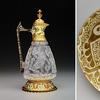Dallas Auction Gallery to Sell Imperial Porcelain Vases Made for the Russian Czar
- DALLAS, Texas
- /
- March 14, 2013
On April 17, the Dallas Auction Gallery in Texas will sell a pair of extremely rare and exquisite 19th century vases made by the Imperial Porcelain Factory for the Russian czar. The vases will sell as a pair, and their estimate is $1 million to $1.5 million.
The precious vases mysteriously disappeared after the communists seized power in 1917 and plunged Russia into civil war, but a decade later they found their way to an American collection. In circumstances not fully clear, the 1.3-meter high vases probably left Russia during the sell-off of Imperial treasures that was the policy of the new Soviet government. In the mid 1920s the vases appeared for sale at the famous Bernheimer Gallery in Munich, Germany, and were subsequently purchased by American oil magnate, Frank Buttram, and his wife, who were touring Europe. The couple’s travel diary clearly lists their purchase of the Russian vases.
Mr Buttram (1886-1966) was born into a family of native American famers from the Chickasaw Nation. He eventually became one of Oklahoma’s famous “oil kings,” creating Buttram Petroleum Company, one of America’s largest oil companies before World War II. His heirs, who also reside in Oklahoma, are selling the vases.
Russian Imperial vases are some of the most valuable porcelain items ever made, selling for as much as $5 million for a pair. Their great value owes to the fact that they were made for the Czar and the empire’s most powerful aristocrats. The vases are large and difficult to produce, and they were made by the leading porcelain artists and craftsmen of the period.
"The rediscovery of these two Imperial vases is very exciting, first and foremost because they are of extremely high quality and date from the reign of Nicholas I, the golden era of Russian porcelain production" said Ekaterina Khmelnitskaya, curator of Russian porcelain at the State Hermitage Museum in St Petersburg, the former Imperial capital where the vases were made. "In addition, it’s an incredible surprise to find Russian Imperial vases in the heart of the American "Wild" West, which Soviet propaganda told us was a brutal and lawless place."
In September Ms Khmelnitskaya studied the vases in an independent private capacity, and confirmed their authenticity.
The bodies of both bandeau shaped vases have a rich plum colored ground, and are decorated with handles shaped as acanthus scrolls. The superb execution of the raised ornamentation creates an illusion of gilded chased metal or bronze. One vase is decorated with a copy of a painting from the collection of the Hermitage Museum -- "The Concert" by Dutch painter, A. Palamedes (1600-1673).
"Based on archival records, we know that this painting was sent from the Hermitage to the Imperial Porcelain Factory in 1832 in order to make a copy on a vase," said Ms. Khmelnitskaya. "The painting on this vase was created by Semyon Golov (1783-1849), who was one of the best copyists, specializing in historical paintings and painting figures."
The painting that was copied on the second vase cannot be identified. According to Hermitage experts, we know that this 17th century Dutch painting is no longer in the Hermitage. It probably was sold abroad with other artworks in the 1920s. But we do know that Vasily Meshcheriakov (1781-?) was the author of the porcelain copy of this painting. He was one of the factory’s best copyists, who frequently reproduced pictures on vases, many of which can still be seen in the Hermitage porcelain collection, and in other major Russian museums.
Experts are very excited by the fact that the Imperial vases in Dallas are close relatives of a pair that is still in the Hermitage Museum.
"The Hermitage has a pair of the same bandeau-shaped vases with a blue background and with the same gilded décor," said Ms Khmelnitskaya. "They were created in 1831 and based on our archival research they were presented to Emperor Nicholas I as an Easter gift. The paintings on these vases were also made by the artists Golov and Meshcheriakov. Most likely after they finished the pair still in the Hermitage they began to paint the pair of vases at the Dallas Auction Gallery."
Russian Imperial porcelain – a brief history
The Imperial Porcelain Factory was founded in 1744 by Empress Elizabeth I, the daughter of Peter the Great. It is one of oldest porcelain factories in the West, and was the personal property of the Russian royal family, primarily working to outfit imperial palaces with the finest tableware and items for interior decoration.
During the reign of Nicholas I (1796 - 1855, emperor since 1825), the Imperial Porcelain Factory achieved an unprecedented level of production. Professional masters, benefitting from an improved production cycle, perfected the artistic quality of the factory’s output. Large porcelain vases were the most prized items, and they were given the best spots in palace interiors: placed above fireplaces, rested on special pedestals in the center or corners of rooms, and flanked grand staircases.
The IPF has survived revolution, nationalizaton, and war, and today it still produces porcelain, owned by Moscow businessman, Nikolai Tsvetkov and his wife, Galina. The factory’s museum, however, is owned by the State Hermitage Museum, and thus we have a near complete history of Russian Imperial porcelain.

100x100_n.jpg)



100x100_c.jpg)










